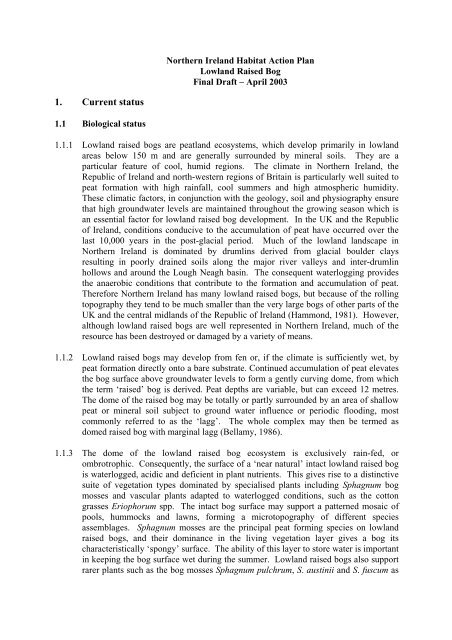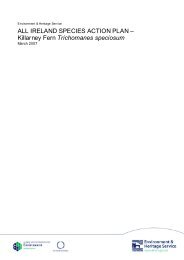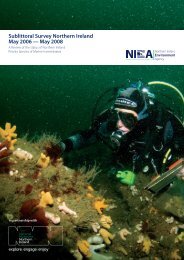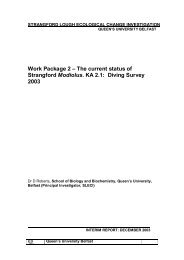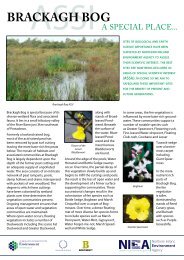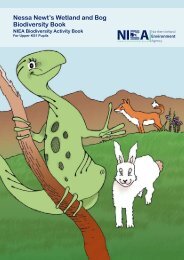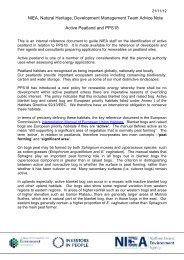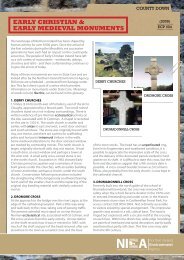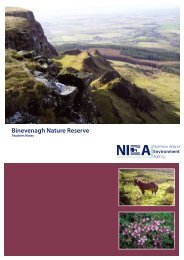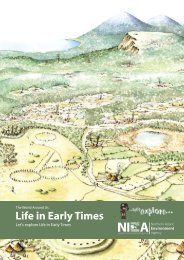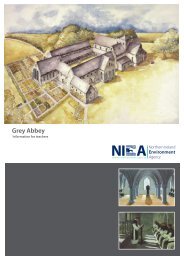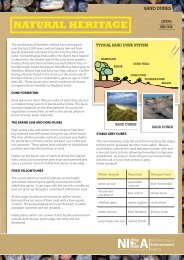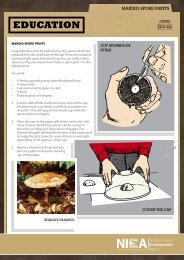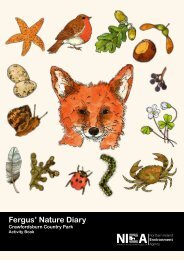Lowland Raised Bog - Department of the Environment
Lowland Raised Bog - Department of the Environment
Lowland Raised Bog - Department of the Environment
Create successful ePaper yourself
Turn your PDF publications into a flip-book with our unique Google optimized e-Paper software.
1. Current status<br />
1.1 Biological status<br />
Nor<strong>the</strong>rn Ireland Habitat Action Plan<br />
<strong>Lowland</strong> <strong>Raised</strong> <strong>Bog</strong><br />
Final Draft – April 2003<br />
1.1.1 <strong>Lowland</strong> raised bogs are peatland ecosystems, which develop primarily in lowland<br />
areas below 150 m and are generally surrounded by mineral soils. They are a<br />
particular feature <strong>of</strong> cool, humid regions. The climate in Nor<strong>the</strong>rn Ireland, <strong>the</strong><br />
Republic <strong>of</strong> Ireland and north-western regions <strong>of</strong> Britain is particularly well suited to<br />
peat formation with high rainfall, cool summers and high atmospheric humidity.<br />
These climatic factors, in conjunction with <strong>the</strong> geology, soil and physiography ensure<br />
that high groundwater levels are maintained throughout <strong>the</strong> growing season which is<br />
an essential factor for lowland raised bog development. In <strong>the</strong> UK and <strong>the</strong> Republic<br />
<strong>of</strong> Ireland, conditions conducive to <strong>the</strong> accumulation <strong>of</strong> peat have occurred over <strong>the</strong><br />
last 10,000 years in <strong>the</strong> post-glacial period. Much <strong>of</strong> <strong>the</strong> lowland landscape in<br />
Nor<strong>the</strong>rn Ireland is dominated by drumlins derived from glacial boulder clays<br />
resulting in poorly drained soils along <strong>the</strong> major river valleys and inter-drumlin<br />
hollows and around <strong>the</strong> Lough Neagh basin. The consequent waterlogging provides<br />
<strong>the</strong> anaerobic conditions that contribute to <strong>the</strong> formation and accumulation <strong>of</strong> peat.<br />
Therefore Nor<strong>the</strong>rn Ireland has many lowland raised bogs, but because <strong>of</strong> <strong>the</strong> rolling<br />
topography <strong>the</strong>y tend to be much smaller than <strong>the</strong> very large bogs <strong>of</strong> o<strong>the</strong>r parts <strong>of</strong> <strong>the</strong><br />
UK and <strong>the</strong> central midlands <strong>of</strong> <strong>the</strong> Republic <strong>of</strong> Ireland (Hammond, 1981). However,<br />
although lowland raised bogs are well represented in Nor<strong>the</strong>rn Ireland, much <strong>of</strong> <strong>the</strong><br />
resource has been destroyed or damaged by a variety <strong>of</strong> means.<br />
1.1.2 <strong>Lowland</strong> raised bogs may develop from fen or, if <strong>the</strong> climate is sufficiently wet, by<br />
peat formation directly onto a bare substrate. Continued accumulation <strong>of</strong> peat elevates<br />
<strong>the</strong> bog surface above groundwater levels to form a gently curving dome, from which<br />
<strong>the</strong> term ‘raised’ bog is derived. Peat depths are variable, but can exceed 12 metres.<br />
The dome <strong>of</strong> <strong>the</strong> raised bog may be totally or partly surrounded by an area <strong>of</strong> shallow<br />
peat or mineral soil subject to ground water influence or periodic flooding, most<br />
commonly referred to as <strong>the</strong> ‘lagg’. The whole complex may <strong>the</strong>n be termed as<br />
domed raised bog with marginal lagg (Bellamy, 1986).<br />
1.1.3 The dome <strong>of</strong> <strong>the</strong> lowland raised bog ecosystem is exclusively rain-fed, or<br />
ombrotrophic. Consequently, <strong>the</strong> surface <strong>of</strong> a ‘near natural’ intact lowland raised bog<br />
is waterlogged, acidic and deficient in plant nutrients. This gives rise to a distinctive<br />
suite <strong>of</strong> vegetation types dominated by specialised plants including Sphagnum bog<br />
mosses and vascular plants adapted to waterlogged conditions, such as <strong>the</strong> cotton<br />
grasses Eriophorum spp. The intact bog surface may support a patterned mosaic <strong>of</strong><br />
pools, hummocks and lawns, forming a microtopography <strong>of</strong> different species<br />
assemblages. Sphagnum mosses are <strong>the</strong> principal peat forming species on lowland<br />
raised bogs, and <strong>the</strong>ir dominance in <strong>the</strong> living vegetation layer gives a bog its<br />
characteristically ‘spongy’ surface. The ability <strong>of</strong> this layer to store water is important<br />
in keeping <strong>the</strong> bog surface wet during <strong>the</strong> summer. <strong>Lowland</strong> raised bogs also support<br />
rarer plants such as <strong>the</strong> bog mosses Sphagnum pulchrum, S. austinii and S. fuscum as
Nor<strong>the</strong>rn Ireland Habitat Action Plan – <strong>Lowland</strong> <strong>Raised</strong> <strong>Bog</strong> – Final Draft – April<br />
2003<br />
well as a number <strong>of</strong> higher plants which have become increasingly scarce, including<br />
Great Sundew Drosera anglica, Cranberry Vaccinium oxycoccos and <strong>Bog</strong> Rosemary<br />
Andromeda polifolia. The marginal lagg, where it still remains, is typically dominated<br />
by Purple Moor-grass Molinia caerulea with scattered scrub dominated by Willow<br />
Salix spp.<br />
1.1.4 The majority <strong>of</strong> <strong>the</strong> lowland raised bog resource has been damaged to some extent,<br />
with much <strong>of</strong> it drained, cutover or improved for agriculture. Cutover bog describes<br />
any site where some <strong>of</strong> <strong>the</strong> peat has been removed by hand or more recently by<br />
mechanical means, mainly for fuel, leaving some depth <strong>of</strong> peat behind. In Counties<br />
Down and Armagh, <strong>the</strong>re is little intact bog remaining with <strong>the</strong> majority <strong>of</strong> <strong>the</strong><br />
resource cutover and/or reclaimed. Fur<strong>the</strong>r west and in County Antrim, mechanised<br />
peat extraction is more frequently associated with intact surfaces, <strong>the</strong> cuttings<br />
restricted to <strong>the</strong> periphery <strong>of</strong> <strong>the</strong> site where it is drier and easily accessible. These<br />
cuttings, especially those that have been cut by hand and gradually abandoned over<br />
<strong>the</strong> years, have a varied topography and generally support a range <strong>of</strong> habitats.<br />
Although many cutover lowland raised bogs have been reclaimed for agriculture or<br />
afforested, many areas retain semi-natural habitats <strong>of</strong> nature conservation importance.<br />
Whilst many former lowland raised bogs have regenerated with typical bog vegetation<br />
including Sphagnum mosses, o<strong>the</strong>rs are now best considered as examples <strong>of</strong> fen,<br />
heath, swamp or wet woodland.<br />
1.1.5 Within Nor<strong>the</strong>rn Ireland, lowland raised bog encompasses a range <strong>of</strong> plant<br />
communities that are similar to those identified in <strong>the</strong> National Vegetation<br />
Classification (NVC) <strong>of</strong> Great Britain (Rodwell, 1991). NVC descriptions and codes<br />
are given to associations <strong>of</strong> plants that are characteristic <strong>of</strong> particular environmental<br />
and management conditions. Plant communities that are typical <strong>of</strong> natural raised bogs<br />
include <strong>the</strong> M2 Sphagnum cuspidatum/recurvum and to a lesser extent M1 S.<br />
auriculatum bog pool communities, M17 Scirpus cespitosus - Eriophorum vaginatum<br />
blanket mire and M18 Erica tetralix - Sphagnum papillosum raised and blanket mire.<br />
A number <strong>of</strong> additional NVC communities are characteristic <strong>of</strong> <strong>the</strong> extensive areas <strong>of</strong><br />
lowland raised bog which has been subject to some disturbance such as drainage or<br />
peat-cutting. These include M15 Scirpus cespitosus - Erica tetralix wet heath, M20<br />
Eriophorum vaginatum blanket and raised mire, M25 Molinia caerulea - Potentilla<br />
erecta mire, which may also be associated with <strong>the</strong> natural lagg and W4 Betula<br />
pubescens - Molinia caerulea woodland. In some instances, peat cuttings completely<br />
remove <strong>the</strong> acidic peat layer extending to a depth below <strong>the</strong> surrounding groundwater<br />
levels. Under <strong>the</strong>se circumstances, ground water influence provides some nutrient<br />
enrichment and promotes <strong>the</strong> development <strong>of</strong> fen communities.<br />
1.1.6 The conservation value <strong>of</strong> lowland raised bogs can be determined by <strong>the</strong> condition <strong>of</strong><br />
<strong>the</strong> habitat. Favourable condition is defined by setting targets or target ranges for a<br />
series <strong>of</strong> different attributes. These are components or characteristics <strong>of</strong> <strong>the</strong><br />
vegetation that are relatively easy to measure, but which are reliable indicators <strong>of</strong> <strong>the</strong><br />
‘health’ <strong>of</strong> <strong>the</strong> habitat. For lowland raised bog, <strong>the</strong>se include <strong>the</strong> cover <strong>of</strong> Sphagnum<br />
bog-mosses and dwarf-shrubs, <strong>the</strong> vegetation structure, <strong>the</strong> presence <strong>of</strong> certain key<br />
indicator species, and <strong>the</strong> absence <strong>of</strong> vegetation, species or factors associated with<br />
disturbance such as burning, overgrazing or drainage. The standards for assessing<br />
favourable condition <strong>of</strong> lowland raised bog, taking cognisance <strong>of</strong> <strong>the</strong> variability <strong>of</strong> <strong>the</strong>
Nor<strong>the</strong>rn Ireland Habitat Action Plan – <strong>Lowland</strong> <strong>Raised</strong> <strong>Bog</strong> – Final Draft – April<br />
2003<br />
habitat across Nor<strong>the</strong>rn Ireland, have still to be finalised for <strong>the</strong> purposes <strong>of</strong> this<br />
habitat action plan.<br />
1.1.7 <strong>Lowland</strong> raised bogs also support a distinctive range <strong>of</strong> animals including breeding<br />
waders such as Curlew Numenius arquata, Skylark Alauda arvensis and a variety <strong>of</strong><br />
invertebrates. Rare and localised invertebrates such as <strong>the</strong> Large Heath Butterfly<br />
Coenonympha tullia are found on some lowland raised bog sites.<br />
1.1.8 Peat also preserves a unique and irreplaceable record <strong>of</strong> past human activity, ecology<br />
and climate. Archaeological research has revealed much evidence <strong>of</strong> human activity<br />
through <strong>the</strong> preservation <strong>of</strong> artefacts such as canoes, bog butter and even human<br />
bodies. The peat sequence also holds information on past ecology and climate in <strong>the</strong><br />
form <strong>of</strong> sediments and pollen. Several lowland raised bogs are also <strong>of</strong> international<br />
importance for vulcanism over much <strong>of</strong> <strong>the</strong> Holocene (post 10,000 years before<br />
present) with volcanic glass shards (tephra) recorded in <strong>the</strong> peat column. These bogs<br />
are also <strong>of</strong> international importance for peat stratigraphy providing much <strong>of</strong> <strong>the</strong><br />
dendrochronology for radiocarbon calibration (Pilcher & Hall, 1997).<br />
1.1.9 As elsewhere across north-west Europe, <strong>the</strong>re has been a dramatic decline in <strong>the</strong><br />
extent <strong>of</strong> lowland raised bog since around <strong>the</strong> start <strong>of</strong> <strong>the</strong> nineteenth century. The area<br />
<strong>of</strong> lowland raised bog in <strong>the</strong> UK retaining a largely undisturbed surface is estimated to<br />
have diminished by around 94 % from c95,000 ha to c6,000 ha today (England 37,500<br />
ha reduced to 500 ha, Scotland 28,000 ha to 2,500 ha, Wales 4,000 ha to 800 ha,<br />
Nor<strong>the</strong>rn Ireland 25,000 ha to 2,000 ha). Similarly, in <strong>the</strong> Republic <strong>of</strong> Ireland <strong>the</strong>re<br />
has been a loss <strong>of</strong> lowland raised bog habitat from its original 308,742 ha to 25,189 ha<br />
(8%) which still has a nature conservation value (Foss et al, 2001).<br />
1.1.10 The distribution and condition <strong>of</strong> Nor<strong>the</strong>rn Ireland’s bogs has been assessed through a<br />
combination <strong>of</strong> commissioned research and surveys carried out by <strong>Environment</strong> and<br />
Heritage Service (EHS) staff. In 1988, <strong>the</strong> Nor<strong>the</strong>rn Ireland Peatland Survey was<br />
completed by The Queen’s University <strong>of</strong> Belfast (Cruickshank & Tomlinson, 1988).<br />
This major resource inventory used aerial photographs to record and map <strong>the</strong><br />
distribution <strong>of</strong> different types <strong>of</strong> peatland (lowland raised bog and blanket bog) and to<br />
indicate <strong>the</strong> condition <strong>of</strong> each site. The Nor<strong>the</strong>rn Ireland Peatland Survey defined<br />
peatland as wetland still covered with bog vegetation or with clear evidence <strong>of</strong> peat<br />
accumulation. It excluded land reclaimed for agriculture or under forest cover and<br />
hence, <strong>the</strong> overall figures for each category are to some extent an underestimate <strong>of</strong> <strong>the</strong><br />
total resource. Although <strong>the</strong> most recent photographs were used, for some parts <strong>of</strong><br />
Nor<strong>the</strong>rn Ireland, coverage was only available from <strong>the</strong> 1960s making accurate<br />
assessment very difficult in those areas. However, <strong>the</strong> survey is <strong>the</strong> only one that<br />
gives a complete picture <strong>of</strong> <strong>the</strong> total peatland resource in Nor<strong>the</strong>rn Ireland.<br />
Cruickshank and Tomlinson estimated that <strong>the</strong> original lowland raised bog resource<br />
was 25,196 ha and that only 2,270 ha, about 9%, was still intact.<br />
1.1.11 A site survey <strong>of</strong> lowland raised bogs with an intact surface <strong>of</strong> 10 ha and over was<br />
undertaken by <strong>Environment</strong> Service staff in <strong>the</strong> late 1980s (Leach & Corbett, 1987).<br />
This was a preliminary survey, aimed at identifying <strong>the</strong> most important sites for nature<br />
conservation. Detailed work on a number <strong>of</strong> additional sites has been carried out<br />
since <strong>the</strong>n. The revised area <strong>of</strong> 2,000 ha (1.1.7) is based on this additional information
Nor<strong>the</strong>rn Ireland Habitat Action Plan – <strong>Lowland</strong> <strong>Raised</strong> <strong>Bog</strong> – Final Draft – April<br />
2003<br />
from field survey by EHS staff. It is estimated that 1,600 ha <strong>of</strong> this intact lowland<br />
raised bog is in a near natural state supporting specialised plant assemblages typical <strong>of</strong><br />
a waterlogged peat surface. This suggests that approximately 400 ha <strong>of</strong> intact lowland<br />
raised bog is in a degraded state supporting < 10% Sphagnum moss cover.<br />
1.1.12 Historically, <strong>the</strong> greatest decline <strong>of</strong> lowland raised bog has occurred through peat<br />
cutting, with 77.5% lost to hand-cutting for fuel (Cruickshank et al, 1993). However,<br />
during <strong>the</strong> second half <strong>of</strong> <strong>the</strong> twentieth century <strong>the</strong>re was an accelerated rate <strong>of</strong> peat<br />
loss due to drainage to improve <strong>the</strong> productivity for agriculture and forestry. More<br />
recently, mechanised peat extraction both for horticultural purposes and as a fuel has<br />
fur<strong>the</strong>r increased <strong>the</strong> rate <strong>of</strong> peat loss. In <strong>the</strong> 1980s and 1990s, planning permission<br />
for <strong>the</strong> extraction <strong>of</strong> horticultural peat was granted for approximately 650 ha <strong>of</strong><br />
lowland raised bog. In addition, <strong>the</strong> early 1980s saw <strong>the</strong> introduction <strong>of</strong> tractor-drawn<br />
auger machines that changed patterns <strong>of</strong> fuel peat extraction on lowland raised bogs<br />
with cutting taking place for both domestic and commercial purposes.<br />
1.1.13 The Nor<strong>the</strong>rn Ireland Countryside Survey (Cooper, McCann & Meharg, 2002) which<br />
aimed to monitor land use change, shows a significant decrease <strong>of</strong> 8% in wet bog<br />
vegetation in <strong>the</strong> lowlands (< 150m) between 1992 and 1998. This indicates a decline<br />
in <strong>the</strong> condition <strong>of</strong> lowland raised bog (which is largely included in this broad habitat<br />
category). In <strong>the</strong> future, it is possible that some bogs may gradually dry out as a result<br />
<strong>of</strong> prolonged cutting and past drainage activities resulting in a general lowering <strong>of</strong><br />
groundwater tables.<br />
1.2 Links with o<strong>the</strong>r action plans<br />
1.2.1 This <strong>Lowland</strong> <strong>Raised</strong> <strong>Bog</strong> Action Plan identifies specific targets and actions required<br />
to deliver Nor<strong>the</strong>rn Ireland’s contribution to <strong>the</strong> UK <strong>Lowland</strong> <strong>Raised</strong> <strong>Bog</strong> Action<br />
Plan, published in 1999 (UK Biodiversity Group, 1999).<br />
1.2.2 Although lowland raised bogs throughout Nor<strong>the</strong>rn Ireland are generally surrounded<br />
by mineral soils intensively managed for agriculture, many areas <strong>of</strong> cutover bog now<br />
support o<strong>the</strong>r habitats <strong>of</strong> nature-conservation importance. These habitats include<br />
localised fen communities and more extensive areas <strong>of</strong> wet woodland which form an<br />
integral part <strong>of</strong> many lowland raised bog systems. These habitats are hydrologically<br />
linked to <strong>the</strong> lowland raised bog and <strong>of</strong>ten act as a valuable buffer between <strong>the</strong> active<br />
raised bog and <strong>the</strong> agricultural land beyond. Both fen and wet woodland will be<br />
subject to <strong>the</strong>ir own Nor<strong>the</strong>rn Ireland action plans. The requirements <strong>of</strong> <strong>the</strong>se habitats<br />
should be taken into account during <strong>the</strong> implementation <strong>of</strong> this plan.<br />
1.2.3 Within Nor<strong>the</strong>rn Ireland, lowland raised bog habitats, including both intact surfaces<br />
and regenerating cutover bog, are important for a number <strong>of</strong> UK priority species<br />
identified as part <strong>of</strong> <strong>the</strong> UK Biodiversity Action Plan programme. These include<br />
Skylark which breeds on lowland raised bog in addition to a number <strong>of</strong> o<strong>the</strong>r open<br />
habitats. The requirements <strong>of</strong> this species should be taken into account during <strong>the</strong><br />
implementation <strong>of</strong> this plan. In addition, Marsh Clubmoss Lycopodiella inundatum,<br />
which in Nor<strong>the</strong>rn Ireland is restricted to <strong>the</strong> old shore and bed <strong>of</strong> Annagarriff Lough<br />
(which was drained in 1913) is closely associated with <strong>the</strong> lowland raised bog habitats
Nor<strong>the</strong>rn Ireland Habitat Action Plan – <strong>Lowland</strong> <strong>Raised</strong> <strong>Bog</strong> – Final Draft – April<br />
2003<br />
at Peatlands Park. Re-wetting <strong>of</strong> cutover bog at <strong>the</strong> Park may threaten <strong>the</strong> continued<br />
existence <strong>of</strong> Marsh Clubmoss in Nor<strong>the</strong>rn Ireland.<br />
1.2.4 In addition to <strong>the</strong> UK priority species list, a number <strong>of</strong> additional priority species and<br />
species <strong>of</strong> conservation concern within a Nor<strong>the</strong>rn Ireland context have been<br />
identified. Nor<strong>the</strong>rn Ireland priority species primarily associated with peatlands<br />
including lowland raised bog are breeding Curlew, Red Grouse Lagopus lagopus<br />
scoticus, <strong>the</strong> Bordered Grey moth Selidosema brunnearia and Irish Hare Lepus<br />
timidus hibernicus which is associated with a number <strong>of</strong> o<strong>the</strong>r open habitats in<br />
addition to lowland raised bog. The requirements <strong>of</strong> <strong>the</strong>se species should be taken<br />
into account during <strong>the</strong> implementation <strong>of</strong> this plan. Action plans are currently being<br />
drafted for a number <strong>of</strong> Nor<strong>the</strong>rn Ireland priority species, and a local Curlew Species<br />
Action Plan and Irish Hare Species Action Plan have been published (DOE, 2000).<br />
2. Current factors affecting <strong>the</strong> habitat<br />
2.1 There are three key conditions which have to be maintained if lowland raised peat<br />
bogs are to retain <strong>the</strong>ir characteristic features.<br />
• hydrology - any increase in water loss will destabilise <strong>the</strong> system.<br />
• nutrient inputs – because <strong>the</strong> intact bog surface is rain-fed, <strong>the</strong> nature <strong>of</strong> <strong>the</strong> peat is<br />
acid and nutrient-poor and supports a number <strong>of</strong> specialised plants. Significant<br />
increases in <strong>the</strong> base or nutrient-status <strong>of</strong> <strong>the</strong> system will alter <strong>the</strong> vegetation cover<br />
in favour <strong>of</strong> non-bog species.<br />
• surface vegetation integrity - <strong>the</strong> living layer <strong>of</strong> vegetation acts as a natural<br />
regulator for water loss. Destruction or alteration <strong>of</strong> <strong>the</strong> vegetation will have<br />
significant implications for <strong>the</strong> long-term stability <strong>of</strong> <strong>the</strong> ecosystem as a whole.<br />
Factors which disrupt <strong>the</strong> balance <strong>of</strong> <strong>the</strong>se conditions, or which lead more directly to<br />
<strong>the</strong> destruction <strong>of</strong> both intact and <strong>the</strong> adjacent cutover lowland raised bog habitats are<br />
described below.<br />
2.1.1 Peat cutting - <strong>the</strong> extraction <strong>of</strong> peat by hand and more recently by machine for fuel.<br />
2.1.2 Peat milling - <strong>the</strong> extraction <strong>of</strong> peat for horticulture.<br />
2.1.3 Mineral extraction - <strong>the</strong> extraction <strong>of</strong> underlying minerals beneath <strong>the</strong> peat deposits.<br />
2.1.4 Drainage - lowland raised bogs drained ei<strong>the</strong>r directly or indirectly (eg via historical<br />
domestic peat cutting).<br />
2.1.5 Burning - lowland raised bogs are frequently subjected to burning on an ad hoc basis.<br />
Fires on raised bog habitats frequently burn out <strong>of</strong> control, destroying sensitive<br />
species, especially <strong>the</strong> cover <strong>of</strong> Sphagnum bog mosses.<br />
2.1.6 Regional drainage pressures - lowland raised bogs frequently occur in drained<br />
agricultural landscapes. Perimeter drainage and subsequent agricultural
Nor<strong>the</strong>rn Ireland Habitat Action Plan – <strong>Lowland</strong> <strong>Raised</strong> <strong>Bog</strong> – Final Draft – April<br />
2003<br />
intensification may disrupt <strong>the</strong> hydrological integrity <strong>of</strong> lowland raised bogs causing<br />
<strong>the</strong> surface layers to dry out and may also limit rewetting potential <strong>of</strong> certain sites.<br />
2.1.7 Agricultural improvement – cutover bog in-filled and topped with soil has frequently<br />
been converted to pasture in <strong>the</strong> past and can be <strong>of</strong> local significance.<br />
2.1.8 Grazing - rough grazing occurs on some lowland raised bogs and is frequently<br />
accompanied by drainage, trampling, burning and surface contamination with feed and<br />
dung.<br />
2.1.9 Forestry - in addition to <strong>the</strong> direct hydrological and physical impacts <strong>of</strong> existing<br />
plantations on deep peat, mature trees act as an invasive seed source in neighbouring<br />
lowland raised bog areas. There is currently a presumption against new planting on<br />
undisturbed raised bog and cutover raised bog capable <strong>of</strong> natural regeneration as<br />
raised bog. (DANI, 1993).<br />
2.1.10 Scrub encroachment - Downy Birch Betula pubescens scrub and woodland which<br />
frequently develops in cuttings around <strong>the</strong> periphery <strong>of</strong> lowland raised bogs can<br />
encroach onto <strong>the</strong> intact surface, especially where <strong>the</strong> hydrological integrity <strong>of</strong> <strong>the</strong> bog<br />
has been damaged resulting in drying <strong>of</strong> <strong>the</strong> surface peat.<br />
2.1.11 Recreation and game management - such as clay pigeon shooting or pheasant rearing<br />
is usually very limited in extent and confined to <strong>the</strong> margins <strong>of</strong> <strong>the</strong> raised bog.<br />
Localised surface trampling and contamination with lead, feed and droppings can<br />
occur.<br />
2.1.12 Waste disposal – cutover bogs have been used as designated waste disposal sites in<br />
<strong>the</strong> past and are frequently used for illegal dumping <strong>of</strong> agricultural and domestic<br />
waste. This can be <strong>of</strong> local significance.<br />
2.1.13 Pollution - contamination from adjacent landfill or agricultural drainage, fertiliser drift<br />
during its application, or localised dumping or fly-tipping, may be significant at<br />
certain sites.<br />
2.1.14 Nutrient enrichment - nitrogen enrichment caused by atmospheric deposition could<br />
potentially lead to vegetation changes, especially bryophyte and lichen interest. Any<br />
change to Sphagnum mosses in particular, would have wider implications for <strong>the</strong><br />
whole bog.<br />
2.1.15 Planning developments - land reclamation for urban expansion, rural dwellings and<br />
development <strong>of</strong> <strong>the</strong> road network, may affect some lowland raised bogs with longterm<br />
repercussions on <strong>the</strong> stability <strong>of</strong> <strong>the</strong> ecosystem.<br />
2.1.16 Climate Change - summary predictions for temperature and sea level rise as a result <strong>of</strong><br />
global warming have been modelled by <strong>the</strong> ‘MONARCH project’ (Harrison et al,<br />
2001). The prediction <strong>of</strong> higher summer temperatures and drought in sou<strong>the</strong>rn and<br />
central England may lead to <strong>the</strong> remaining bogs drying out in that region, possibly<br />
extending as far as south east Ireland. This may be counterbalanced by increased<br />
rainfall fur<strong>the</strong>r north. In Nor<strong>the</strong>rn Ireland, it is predicted that conditions for bog
Nor<strong>the</strong>rn Ireland Habitat Action Plan – <strong>Lowland</strong> <strong>Raised</strong> <strong>Bog</strong> – Final Draft – April<br />
2003<br />
growth will be improved due to increased rainfall, especially in winter, which toge<strong>the</strong>r<br />
with milder winters, will result in extended growth periods. However, although<br />
suitable climatic conditions will persist for <strong>the</strong> maintenance and restoration <strong>of</strong> lowland<br />
raised bog in Nor<strong>the</strong>rn Ireland, <strong>the</strong> species composition <strong>of</strong> <strong>the</strong> plant communities may<br />
well change.<br />
3. Current action<br />
3.1 Legal status<br />
3.1.1 Statutory site designation plays an important part in <strong>the</strong> conservation <strong>of</strong> this habitat.<br />
Many <strong>of</strong> <strong>the</strong> best examples <strong>of</strong> lowland raised bog are given legal protection both<br />
nationally as Areas <strong>of</strong> Special Scientific Interest (ASSIs) and National Nature<br />
Reserves (NNRs), and internationally as Ramsar sites and candidate Special Areas <strong>of</strong><br />
Conservation (cSACs).<br />
3.1.2 Under <strong>the</strong> Nature Conservation and Amenity Lands (Nor<strong>the</strong>rn Ireland) Order 1985,<br />
22 lowland raised bogs are protected as ASSIs representing around 10% (>2000 ha) <strong>of</strong><br />
<strong>the</strong> total lowland raised bog resource, but incorporating over 45% (c 910 ha) <strong>of</strong> <strong>the</strong><br />
remaining intact surface. Fur<strong>the</strong>r declarations, which will be identified and declared<br />
by <strong>the</strong> <strong>Department</strong> <strong>of</strong> <strong>the</strong> <strong>Environment</strong> (DOE) through <strong>Environment</strong> and Heritage<br />
Service (EHS), are planned within <strong>the</strong> next five years. Most <strong>of</strong> <strong>the</strong> ASSIs are<br />
privately owned with parts covered by management agreements between EHS and <strong>the</strong><br />
landowners and occupiers. As a consequence, peat extraction for fuel has virtually<br />
ceased on all lowland raised bog ASSIs. EHS has recently launched a new<br />
Management <strong>of</strong> Special Sites (MOSS) Scheme for landowners and occupiers aimed at<br />
establishing <strong>the</strong> favourable management <strong>of</strong> designated sites to arrest, and if possible<br />
reverse, any negative trends in lowland raised bog condition.<br />
3.1.3 A number <strong>of</strong> lowland raised bog ASSIs are owned, partially owned or leased by EHS<br />
and are managed for nature conservation. Several <strong>of</strong> <strong>the</strong>se including Garry <strong>Bog</strong>,<br />
Black <strong>Bog</strong> and Ballynahone <strong>Bog</strong> are also designated as NNRs. Where appropriate,<br />
positive management <strong>of</strong> <strong>the</strong>se sites has been undertaken by EHS using best-practice<br />
management techniques. Ballynahone <strong>Bog</strong>, for example, is currently undergoing a<br />
major restoration project, which demonstrates aspects <strong>of</strong> hydrological management<br />
including drain blocking.<br />
3.1.4 Most international designations are underpinned by ASSI declaration. One <strong>of</strong> <strong>the</strong><br />
earliest international nature conservation designations resulted from a ga<strong>the</strong>ring at<br />
Ramsar in Iran, where <strong>the</strong> Convention on Wetlands <strong>of</strong> International Importance<br />
especially as Waterfowl Habitat; <strong>the</strong> Ramsar Convention, was adopted at a meeting <strong>of</strong><br />
countries concerned with wetland and waterfowl conservation in 1971. The UK<br />
government signed <strong>the</strong> Convention in 1973 and accepted a commitment to promote<br />
both <strong>the</strong> conservation <strong>of</strong> particular sites and <strong>the</strong> wise use <strong>of</strong> wetlands within its<br />
territory. Each country is required to designate wetlands in accordance with agreed<br />
criteria for inclusion in a list <strong>of</strong> Wetlands <strong>of</strong> International Importance, generally<br />
known as Ramsar sites. To date Nor<strong>the</strong>rn Ireland has listed four lowland raised bog<br />
ASSIs as Ramsar sites. It is likely that additional sites will be required in <strong>the</strong> future as
Nor<strong>the</strong>rn Ireland Habitat Action Plan – <strong>Lowland</strong> <strong>Raised</strong> <strong>Bog</strong> – Final Draft – April<br />
2003<br />
<strong>the</strong> criteria for Ramsar designation have been reviewed (6 th Ramsar Conference <strong>of</strong><br />
Parties, 1996).<br />
3.1.5 In 1992, <strong>the</strong> European Community (EC) adopted <strong>the</strong> Council Directive 92/43/EEC on<br />
<strong>the</strong> conservation <strong>of</strong> natural habitats and <strong>of</strong> wild fauna and flora, known as <strong>the</strong><br />
‘Habitats Directive’. The Habitats Directive requires member states to designate and<br />
manage SACs for habitats (listed in Annex 1 <strong>of</strong> <strong>the</strong> Directive) and species (listed in<br />
Annex 2). A small proportion <strong>of</strong> <strong>the</strong>se habitats and species, which are considered to<br />
be most in need <strong>of</strong> conservation at a European level, are given priority status. Annex<br />
1 contains two lowland raised bog habitats; ‘active raised bog’ and ‘degraded raised<br />
bog’. The active raised bog category is afforded priority habitat status and includes<br />
areas which still support a significant area <strong>of</strong> vegetation that is normally peat forming,<br />
as well as those areas that are temporarily at a standstill (after fire for example). This<br />
includes both intact and regenerating cutover bog. Degraded raised bogs are areas<br />
where <strong>the</strong>re has been a widespread disruption to <strong>the</strong> hydrology <strong>of</strong> <strong>the</strong> peat body<br />
leading to pronounced surface desiccation or peat wastage. This results in <strong>the</strong> loss <strong>of</strong><br />
species and/or changes to <strong>the</strong> composition <strong>of</strong> species assemblages.<br />
3.1.6 The original UK list <strong>of</strong> cSACs was submitted to <strong>the</strong> EC in July 1999 and included 21<br />
cSACs from Nor<strong>the</strong>rn Ireland, four <strong>of</strong> which were included for <strong>the</strong>ir active raised bog<br />
interest. In 1999, this list was <strong>the</strong>n assessed within <strong>the</strong> context <strong>of</strong> <strong>the</strong> relevant biogeographical<br />
region and <strong>the</strong> EC as a whole – a process known as moderation. In<br />
common with many <strong>of</strong> <strong>the</strong> member states, <strong>the</strong> UK cSAC list was judged to provide<br />
insufficient coverage for a number <strong>of</strong> habitats (and species) including lowland raised<br />
bog.<br />
3.1.7 As a result <strong>of</strong> moderation, EHS has processed a fur<strong>the</strong>r 5 lowland raised bog cSACs.<br />
Four <strong>of</strong> <strong>the</strong>se are included in <strong>the</strong> active raised bog category and <strong>the</strong> fifth, Peatlands<br />
Park, includes both active and degraded raised bog interests. By 2001, moderation<br />
had <strong>the</strong>refore resulted in a total <strong>of</strong> nine lowland raised bog cSACs submitted to <strong>the</strong> EC<br />
from Nor<strong>the</strong>rn Ireland - a total <strong>of</strong> 1,537 ha <strong>of</strong> active raised bog (nine sites) and 117 ha<br />
<strong>of</strong> degraded raised bog (one site). The revised UK list includes 43 sites in <strong>the</strong> active<br />
raised bog category interest and 33 sites in <strong>the</strong> degraded raised bog category.<br />
3.1.8 A second moderation meeting in 2002 found <strong>the</strong> UK still insufficient for a few<br />
habitats (and species), including active lowland raised bog. EHS was required to<br />
submit a number <strong>of</strong> additional cSACs in Nor<strong>the</strong>rn Ireland to address this<br />
insufficiency. Six additional active lowland raised bog sites are currently being<br />
considered by EHS and will shortly go out to public consultation.<br />
3.1.9 In <strong>the</strong> Republic <strong>of</strong> Ireland, 29 cSACs have been submitted for lowland raised bog in<br />
<strong>the</strong> active category. Similarly to <strong>the</strong> UK, <strong>the</strong> EC indicated that this is insufficient to<br />
adequately represent <strong>the</strong> resource in <strong>the</strong> Republic <strong>of</strong> Ireland and in response 22<br />
additional active lowland raised bog sites have been notified, but not yet formally sent<br />
to Brussels (Jim Ryan, personal communication, 2003). The total area <strong>of</strong> intact<br />
lowland raised bog conserved in <strong>the</strong>se cSACs is approximately 9,690 ha (c 54% <strong>of</strong> <strong>the</strong><br />
intact resource). In addition, 53 raised bogs have been submitted in <strong>the</strong> degraded<br />
raised bog category including all <strong>of</strong> <strong>the</strong> above sites and an additional two sites which<br />
are submitted for <strong>Bog</strong> Woodland. Sites designated under <strong>the</strong> Habitats Directive will<br />
eventually be part <strong>of</strong> an EC wide network <strong>of</strong> nature conservation sites known as <strong>the</strong><br />
Natura 2000 network.
Nor<strong>the</strong>rn Ireland Habitat Action Plan – <strong>Lowland</strong> <strong>Raised</strong> <strong>Bog</strong> – Final Draft – April<br />
2003<br />
3.1.10 In 2000, <strong>the</strong> Nor<strong>the</strong>rn Ireland Biodiversity Group (NIBG) made its Recommendations<br />
to Government (NIBG, 2000). These were largely accepted by <strong>the</strong> Nor<strong>the</strong>rn Ireland<br />
Executive in 2002, with <strong>the</strong> publication <strong>of</strong> <strong>the</strong> Nor<strong>the</strong>rn Ireland Biodiversity Strategy<br />
(DOE, 2002). The Regional Development Strategy 2025 (DRD, 2001), provides a<br />
framework for sustainable development in Nor<strong>the</strong>rn Ireland which includes <strong>the</strong> full<br />
integration <strong>of</strong> <strong>the</strong> conservation <strong>of</strong> biological diversity and <strong>the</strong> Nor<strong>the</strong>rn Ireland<br />
Biodiversity Strategy. At a local planning level, policies to protect and enhance<br />
biodiversity are being included as part <strong>of</strong> new Development Plans. These include <strong>the</strong><br />
identification <strong>of</strong> Sites <strong>of</strong> Local Nature Conservation Importance (SLNCIs) for<br />
Planning Service. Planning Service is currently considering which SLNCIs will be<br />
formally identified in Development Plans. Where such sites are confirmed in adopted<br />
plans, specific planning policies will be applied to development proposals on those<br />
sites. The SLNCI network will include a significant number <strong>of</strong> lowland raised bog<br />
sites <strong>of</strong> substantive nature conservation interest, which are not designated as ASSI or<br />
NNR.<br />
3.1.11 The development <strong>of</strong> Local Biodiversity Action Plans (LBAPs), probably based on<br />
District Council Areas and/or discrete landscape areas, will help to build on <strong>the</strong><br />
SLNCI network by co-ordinating and informing local biodiversity action.<br />
3.1.12 The date and conditions under which lowland raised bog can be burnt are defined by<br />
Law to protect breeding birds. The burning regulations as stated in <strong>the</strong> Game Law<br />
Amendment Act (Nor<strong>the</strong>rn Ireland), 1951 and amended in <strong>the</strong> Wildlife (Nor<strong>the</strong>rn<br />
Ireland) Order, 1985, make it unlawful in Nor<strong>the</strong>rn Ireland to burn Hea<strong>the</strong>r and<br />
associated dwarf shrub vegetation between <strong>the</strong> 15 th April and <strong>the</strong> 31 st August.<br />
3.2 Management, research and guidance<br />
3.2.1 EHS, as part <strong>of</strong> <strong>the</strong> requirements <strong>of</strong> <strong>the</strong> Habitats Directive, has prepared conservation<br />
objectives for those sites submitted as cSACs. Common standards monitoring<br />
protocols are also being established across <strong>the</strong> UK to assess <strong>the</strong> condition <strong>of</strong> lowland<br />
raised bogs. The current monitoring programme for assessing <strong>the</strong> condition <strong>of</strong><br />
lowland raised bog cSACs in Nor<strong>the</strong>rn Ireland is almost complete. This programme<br />
will be extended to include all lowland raised bog ASSIs.<br />
3.2.2 Management/rehabilitation plans exist for several areas <strong>of</strong> lowland raised bog<br />
managed by EHS as ASSIs and NNRs. In 1988, <strong>the</strong> DOE purchased a large<br />
proportion <strong>of</strong> <strong>the</strong> uncut, but drained, surface <strong>of</strong> Ballynahone <strong>Bog</strong> in County<br />
Londonderry, <strong>the</strong> second largest area <strong>of</strong> uncut lowland raised bog in Nor<strong>the</strong>rn Ireland.<br />
EHS has responsibility for this site and subsequently declared it a NNR. It is<br />
currently leased to <strong>the</strong> Ulster Wildlife Trust (UWT) which is managing <strong>the</strong> restoration<br />
<strong>of</strong> <strong>the</strong> site. O<strong>the</strong>r lowland raised bogs are protected and managed as part <strong>of</strong> a network<br />
<strong>of</strong> nature reserves owned and managed by Forest Service and non-governmental<br />
organisations (NGOs) such as The National Trust (NT) and <strong>the</strong> UWT.<br />
3.2.3 The <strong>Department</strong> <strong>of</strong> Agriculture and Rural Development (DARD), through its<br />
Countryside Management Division (CMD), has developed a series <strong>of</strong> agrienvironment<br />
schemes including <strong>the</strong> <strong>Environment</strong>ally Sensitive Area (ESA) Scheme,
Nor<strong>the</strong>rn Ireland Habitat Action Plan – <strong>Lowland</strong> <strong>Raised</strong> <strong>Bog</strong> – Final Draft – April<br />
2003<br />
<strong>the</strong> New <strong>Environment</strong>ally Sensitive Area (NESA) Scheme and <strong>the</strong> Countryside<br />
Management Scheme (CMS). These schemes are potentially <strong>the</strong> most successful<br />
mechanism <strong>of</strong> contributing to delivery <strong>of</strong> targets listed under action plans for many<br />
species and habitats. Their objective is to protect and enhance semi-natural habitats<br />
such as lowland raised bog by encouraging more sensitive management practices to<br />
allow <strong>the</strong> restoration <strong>of</strong> lowland raised bog vegetation. All three schemes are<br />
voluntary and apply to <strong>the</strong> whole farm.<br />
3.2.4 The Countryside Management Scheme, launched in 1999 was developed with <strong>the</strong><br />
primary aim to maintain and enhance biodiversity and is open to all farmers and<br />
landowners outside ESAs. Where funding is limited, entry into <strong>the</strong> scheme is<br />
competitive, being based on who can <strong>of</strong>fer <strong>the</strong> greatest environmental benefits.<br />
DARD can provide area-based payments on blocks <strong>of</strong> lowland raised bog >1 ha within<br />
<strong>the</strong> farm unit where <strong>the</strong> bog meets clearly defined criteria (smaller sites may be<br />
considered where <strong>the</strong>y form part <strong>of</strong> an area <strong>of</strong> bog which is >1 ha within <strong>the</strong> farm<br />
unit). Where more than 1 ha <strong>of</strong> lowland raised bog is identified on a participating<br />
farm, <strong>the</strong> bog must be brought under agreement and managed according to <strong>the</strong> specific<br />
objectives and prescriptions <strong>of</strong> <strong>the</strong> agri-environment scheme. In recognition <strong>of</strong> <strong>the</strong><br />
value <strong>of</strong> small habitat areas, CMD are proposing that from April 2003, <strong>the</strong> minimum<br />
eligible area for management and payment will be reduced to 0.1 ha. Within agrienvironment<br />
schemes, approximately 1,000 ha <strong>of</strong> lowland raised bog is currently<br />
managed under CMS. Future reviews <strong>of</strong> agri-environment schemes may permit ‘finetuning’<br />
<strong>of</strong> habitat definitions to correspond with delivering targets listed in habitat and<br />
species action plans where appropriate.<br />
3.2.5 The introduction <strong>of</strong> Good Farming Practice (GFP), which is applicable to farmers<br />
receiving Less Favoured Area (LFA) compensatory payments and those who enter<br />
any <strong>of</strong> <strong>the</strong> agri-environment schemes, provides protection for lowland raised bog.<br />
Farmers must comply with a list <strong>of</strong> verifiable standards in relation to GFP and adhere<br />
to <strong>the</strong> Codes <strong>of</strong> Good Agricultural Practice (COGAP). These standards and codes<br />
apply to <strong>the</strong> whole farm and are compatible with <strong>the</strong> need to safeguard <strong>the</strong><br />
environment and maintain <strong>the</strong> countryside by sustainable farming. Over 70% <strong>of</strong><br />
Nor<strong>the</strong>rn Ireland is classified as LFA.<br />
3.2.6 In addition to agri-environment schemes and o<strong>the</strong>r statutory requirements, seminatural<br />
areas, which are likely to be <strong>of</strong> particular environmental importance, are<br />
fur<strong>the</strong>r protected through <strong>the</strong> <strong>Environment</strong>al Impact Assessment (Uncultivated Land<br />
and Semi-Natural Areas) Regulations (Nor<strong>the</strong>rn Ireland) 2001. These regulations,<br />
which came into operation in Nor<strong>the</strong>rn Ireland in February 2002, are administered by<br />
DARD and seek to ensure that agricultural development <strong>of</strong> uncultivated land and<br />
semi-natural areas must first be assessed for environmental significance. This would<br />
include cases where <strong>the</strong>re is currently a direct involvement <strong>of</strong> public bodies and also<br />
landuse changes aimed at restoring or enhancing lowland raised bog habitat.<br />
3.2.7 Forestry is subject to <strong>the</strong> <strong>Environment</strong>al Impact Assessment (Forestry) Regulations<br />
(Nor<strong>the</strong>rn Ireland) 2000, which state that afforestation <strong>of</strong> designated sites, nature<br />
reserves and parks and o<strong>the</strong>r sensitive areas may only be carried out with <strong>the</strong> consent<br />
<strong>of</strong> <strong>the</strong> <strong>Department</strong> <strong>of</strong> Agriculture and Rural Development. Afforestation – <strong>the</strong> DANI<br />
Statement on <strong>Environment</strong>al Policy (1993) states that undisturbed raised bog and cut-
Nor<strong>the</strong>rn Ireland Habitat Action Plan – <strong>Lowland</strong> <strong>Raised</strong> <strong>Bog</strong> – Final Draft – April<br />
2003<br />
over raised bog capable <strong>of</strong> natural regeneration as raised bog should not be afforested.<br />
This statement <strong>of</strong> policy is incorporated into <strong>the</strong> UK Forestry Standard (Forestry<br />
Commission and DANI, 1998), <strong>the</strong> government’s approach to sustainable forestry.<br />
3.2.8 The UK Woodland Assurance Standard (UKWAS Steering Group, 2000), a voluntary<br />
certification standard, requires that valuable semi-natural habitats which have been<br />
colonised, planted, or incorporated into plantations, but which have retained <strong>the</strong>ir<br />
ecological characteristics (or have a high potential to be restored) are being restored or<br />
treated in a manner that does not lead to fur<strong>the</strong>r loss <strong>of</strong> biodiversity or cultural value.<br />
A strategy for prioritisation <strong>of</strong> restoration projects has been developed for <strong>the</strong> Forest<br />
Service estate. Deforestation is also subject to <strong>the</strong> <strong>Environment</strong>al Impact Assessment<br />
(Forestry) Regulations (Nor<strong>the</strong>rn Ireland) 2000.<br />
3.2.9 The Rivers Agency currently works closely and consults with EHS on <strong>the</strong>ir annual<br />
programme <strong>of</strong> works to maintain <strong>the</strong> effective drainage function <strong>of</strong> designated<br />
watercourses where this may have an impact on designated sites <strong>of</strong> nature<br />
conservation importance. This includes both localised operations such as <strong>the</strong><br />
maintenance <strong>of</strong> outfalls for field drains and more significant river maintenance work.<br />
3.2.10 Government policy for <strong>the</strong> protection and conservation <strong>of</strong> peatland was published in<br />
1993 - Conserving Peatland in Nor<strong>the</strong>rn Ireland - A Statement <strong>of</strong> Policy (DOE,<br />
1993a). The policy objectives include opposition to exploitation <strong>of</strong> lowland raised<br />
bogs <strong>of</strong> conservation importance, encouragement for <strong>the</strong> use <strong>of</strong> peat alternatives in<br />
horticulture and <strong>the</strong> construction <strong>of</strong> a classroom for environmental studies at Peatlands<br />
Park.<br />
3.2.11 Within Nor<strong>the</strong>rn Ireland, planning control is administered by Planning Service (DOE).<br />
Planning Policy Statement 2 (PPS2) - Planning and Nature Conservation, contains<br />
policy for <strong>the</strong> protection <strong>of</strong> peatland sites against development. Policy regarding peat<br />
extraction is expressed in <strong>the</strong> Nor<strong>the</strong>rn Ireland Peatland Policy (1993) and is<br />
supplemented by <strong>the</strong> mineral policies contained in A Planning Strategy for Rural<br />
Nor<strong>the</strong>rn Ireland (DOE, 1993b). These policies are currently under review.<br />
3.2.12 There is a significant amount <strong>of</strong> survey information currently available on lowland<br />
rasied bogs in Nor<strong>the</strong>rn Ireland. The lowland raised bog resource was assessed by <strong>the</strong><br />
Nor<strong>the</strong>rn Ireland Peatland Survey (Cruickshank & Tomlinson, 1988) and <strong>the</strong> survey <strong>of</strong><br />
intact lowland raised bogs with a minimum intact surface <strong>of</strong> 10 ha (Leach & Corbett,<br />
1987). In 1997 and 1998, EHS commissioned fur<strong>the</strong>r research to undertake <strong>the</strong> basin<br />
pr<strong>of</strong>iling <strong>of</strong> a number <strong>of</strong> lowland raised bogs in Nor<strong>the</strong>rn Ireland (Grant et al, 1997).<br />
This method gives an indication <strong>of</strong> <strong>the</strong> physical form <strong>of</strong> <strong>the</strong> bog, including peat depth<br />
and underlying topography, from which peat volume can be estimated. This provides<br />
a long-term monitoring baseline, for measuring peat growth/decline on a number <strong>of</strong><br />
key sites. This research could be extended to include topics not covered well to date,<br />
such as vegetation dynamics, hydrology, vertebrate and invertebrate populations and<br />
<strong>the</strong> peat archive.<br />
3.2.13 Many <strong>of</strong> <strong>the</strong> current projects to develop and improve <strong>the</strong> management <strong>of</strong> lowland<br />
raised bog are described in <strong>the</strong> UK Biodiversity group Tranche 2 Action Plans (UK<br />
Biodiversity Group, 1999). In 1995, <strong>the</strong> Scottish Wildlife Trust held an international<br />
Peatland Convention, <strong>the</strong> proceedings <strong>of</strong> which (Conserving Peatlands) were<br />
published in 1997 (Scottish Wildlife Trust, 1997). The Project also published
Nor<strong>the</strong>rn Ireland Habitat Action Plan – <strong>Lowland</strong> <strong>Raised</strong> <strong>Bog</strong> – Final Draft – April<br />
2003<br />
Conserving bogs: <strong>the</strong> management handbook (Brookes & Stoneman, 1997) which is a<br />
best practice guide on management and rehabilitation <strong>of</strong> lowland raised bogs.<br />
3.2.14 The nineteenth report <strong>of</strong> <strong>the</strong> Royal Commission on <strong>Environment</strong>al Pollution (1996),<br />
made over 90 recommendations on soil protection, management and policy, many <strong>of</strong><br />
which were both directly and indirectly relevant to peatlands. Ten recommendations<br />
related specifically to peatlands including <strong>the</strong> development <strong>of</strong> substitutes for peat used<br />
in horticulture, <strong>the</strong> prevention <strong>of</strong> overstocking and a review <strong>of</strong> relevant planning<br />
policies. All <strong>of</strong> <strong>the</strong> recommendations will be carefully considered in <strong>the</strong> next review<br />
<strong>of</strong> Government policy on peatland conservation.<br />
3.2.15 Biological records are currently stored by <strong>the</strong> Museum and Galleries <strong>of</strong> Nor<strong>the</strong>rn<br />
Ireland (MAGNI) at <strong>the</strong> Centre for <strong>Environment</strong>al Data and Recording (CEDaR).<br />
CEDaR was established in 1995 in partnership with EHS, MAGNI and <strong>the</strong> biological<br />
recording community. There are currently over 1.4 million records held by CEDaR<br />
and <strong>the</strong>re are developments underway to make <strong>the</strong>se records more accessible through<br />
<strong>the</strong> Internet. This will be achieved through <strong>the</strong> National Biodiversity Network, a<br />
union <strong>of</strong> organisations throughout <strong>the</strong> UK working toge<strong>the</strong>r to create an information<br />
network <strong>of</strong> biological data providing an accessible data source for biodiversity<br />
information.<br />
3.2.16 Research into alternatives to peat composts by both government and o<strong>the</strong>r agencies<br />
has produced acceptable mulches and soil conditioners. Under <strong>the</strong> Nor<strong>the</strong>rn Ireland<br />
Peatland Policy, <strong>the</strong>re is a government commitment to phase out <strong>the</strong> use <strong>of</strong> peat in<br />
open ground situations in <strong>the</strong> management <strong>of</strong> its estate and to exclude <strong>the</strong> use <strong>of</strong> peat<br />
in all contracts (DOE, 1993a). To date, <strong>the</strong>re is little information available on current<br />
practices regarding <strong>the</strong> use <strong>of</strong> peat in government properties.<br />
3.2.17 The National Trust has recently resolved to eliminate <strong>the</strong> use <strong>of</strong> peat from its gardens<br />
(except in exceptional circumstances) and are currently producing a peatland<br />
protection policy. However, no one product matching peat in its suitability as a<br />
compost substrate for a wide variety <strong>of</strong> uses has been established. Consequently, as<br />
suitable alternatives are not widely available, peat is still widely used in market<br />
gardening and <strong>the</strong> mushroom industry. The introduction <strong>of</strong> financial incentives to<br />
encourage <strong>the</strong> use <strong>of</strong> peat alternatives for horticultural purposes and to encourage<br />
council/community composting or anaerobic digestion facilities may help to reverse<br />
this trend. In Nor<strong>the</strong>rn Ireland, <strong>the</strong> use <strong>of</strong> peat alternatives has not been monitored,<br />
but research in <strong>the</strong> Republic <strong>of</strong> Ireland suggests peat alternatives have made only a<br />
minimal impression with <strong>the</strong> pr<strong>of</strong>essional sector and gardeners (Foss et al, 2001).<br />
Fur<strong>the</strong>r research is required to produce an acceptably good and predictable peat<br />
alternative for <strong>the</strong> pr<strong>of</strong>essional grower and amateur gardener.<br />
3.2.18 Peatlands Park in County Armagh is an educational and visitor facility administered<br />
by EHS, aimed at increasing public awareness <strong>of</strong> both historical and present day<br />
peatland issues. A series <strong>of</strong> leaflets and educational literature has been produced and<br />
is readily available at <strong>the</strong> Information Centre. Guided tours and special events are<br />
also organised on a frequent basis to fur<strong>the</strong>r increase awareness <strong>of</strong> <strong>the</strong> threat to<br />
peatland conservation by continued peat use, both for horticulture and as a fuel. In<br />
response to <strong>the</strong> Nor<strong>the</strong>rn Ireland Peatland Policy (DOE, 1993a), a classroom to<br />
facilitate education groups was opened in 1995. To enhance this facility, <strong>the</strong> first
Nor<strong>the</strong>rn Ireland Habitat Action Plan – <strong>Lowland</strong> <strong>Raised</strong> <strong>Bog</strong> – Final Draft – April<br />
2003<br />
education <strong>of</strong>ficer was employed at Peatlands Park in 1996, to lead and teach school<br />
groups. The preparation and launch <strong>of</strong> <strong>the</strong> Nor<strong>the</strong>rn Ireland Biodiversity Strategy<br />
highlighted <strong>the</strong> urgent need to address biodiversity decline. To fur<strong>the</strong>r promote <strong>the</strong><br />
importance <strong>of</strong> peatland conservation, a new Biodiversity and Education Centre at<br />
Peatlands Park is currently under construction and is due to be opened in 2003. This<br />
centre will seat 160 people in two classrooms. It will be used by school groups on<br />
week days during term-time and will be open to <strong>the</strong> general public at weekends and<br />
during school holidays.<br />
4. Action plan targets<br />
4.1 Maintain <strong>the</strong> current extent and overall distribution <strong>of</strong> near natural intact lowland<br />
raised bog in Nor<strong>the</strong>rn Ireland, estimated at 1,600 ha.<br />
4.2 Ensure that <strong>the</strong> condition <strong>of</strong> <strong>the</strong> current near natural intact lowland raised bog is<br />
maintained where favourable. Improve <strong>the</strong> condition <strong>of</strong> those areas that are<br />
unfavourable through <strong>the</strong> establishment <strong>of</strong> appropriate management regimes and<br />
hydrological conditions.<br />
4.3 Establish where practicable, appropriate hydrological and management regimes for<br />
intact areas which are in a degraded state (< 10 % Sphagnum Cover), but still retain<br />
nature conservation interest (c400 ha). By 2015, aim to achieve management<br />
conditions that are conducive to <strong>the</strong> restoration <strong>of</strong> degraded intact lowland raised bog<br />
towards favourable condition.<br />
4.4 By 2005, identify areas, timescales and targets for <strong>the</strong> conservation, improvement or<br />
restoration <strong>of</strong> significantly altered lowland raised bog, including those areas formerly<br />
cutover for fuel, improved for agriculture or planted with trees.<br />
4.5 By 2006, initiate restoration projects for priority sites according to <strong>the</strong> agreed<br />
timescales.<br />
5. Proposed action with lead agencies<br />
5.1 Policy and legislation<br />
5.1.1 By 2004, initiate a review <strong>of</strong> peat consumption in all sectors and for all purposes.<br />
(ACTION: EHS)<br />
5.1.2 By 2004, initiate discussions with o<strong>the</strong>r government departments to ensure appropriate<br />
consultation mechanisms exist for proposed changes in land-use.<br />
(ACTION: DARD, EHS, Planning Service, Roads Service, Ministry <strong>of</strong> Defence<br />
(MOD), <strong>Department</strong> <strong>of</strong> Enterprise Trade and Investment (DETI))
Nor<strong>the</strong>rn Ireland Habitat Action Plan – <strong>Lowland</strong> <strong>Raised</strong> <strong>Bog</strong> – Final Draft – April<br />
2003<br />
5.1.3 By 2004, review Planning Policy Statement 2 (PPS2) - Planning and Nature<br />
Conservation, taking cognisance <strong>of</strong> <strong>the</strong> experiences gained in <strong>the</strong> rest <strong>of</strong> <strong>the</strong> UK, <strong>the</strong><br />
Republic <strong>of</strong> Ireland and where appropriate, best practice in environmentally sensitive<br />
planning in o<strong>the</strong>r countries.<br />
(ACTION: Planning Service, EHS)<br />
5.1.4 By 2005, produce a Planning Policy Statement (PPS) on mineral development to<br />
incorporate up-dated policies and guidance on peat extraction.<br />
(ACTION: Planning Service, EHS)<br />
5.1.5 Seek through <strong>the</strong> next amendment <strong>of</strong> <strong>the</strong> Planning Order to bring mechanical peat<br />
cutting operations within <strong>the</strong> remit <strong>of</strong> planning control.<br />
(ACTION: DOE)<br />
5.1.6 By 2005, produce a Planning Policy Statement (PPS) on <strong>the</strong> countryside to<br />
incorporate <strong>the</strong> conservation <strong>of</strong> lowland raised bog.<br />
(ACTION: DRD)<br />
5.1.7 By 2005, produce Nor<strong>the</strong>rn Ireland guidelines, through a cross-sectoral steering<br />
group, on <strong>the</strong> requirements <strong>of</strong> lowland raised bog conservation, including issues <strong>of</strong><br />
land use and drainage, in a wider landscape context.<br />
(ACTION: EHS, DARD, Rivers Agency, Forest Service)<br />
5.1.8 By 2005, review <strong>the</strong> Nor<strong>the</strong>rn Ireland Peatland Policy for <strong>the</strong> protection and<br />
conservation <strong>of</strong> peatland habitats incorporating all issues identified in <strong>the</strong> lowland<br />
raised bog and blanket bog HAPs.<br />
(ACTION: EHS, DARD, Planning Service, EPD)<br />
5.1.9 By 2006, ensure that important lowland raised bogs not already identified are<br />
recognised and, where appropriate, site protection policies are included in<br />
Development Plans and o<strong>the</strong>r strategic plans including Local Biodiversity Action<br />
Plans (LBAPs).<br />
(ACTION: Planning Service, EHS, DARD, District Councils)<br />
5.1.10 By 2007, monitor and review <strong>the</strong> effectiveness <strong>of</strong> agri-environment schemes and GFP<br />
initiatives to ensure that lowland raised bogs are being maintained and enhanced<br />
across Nor<strong>the</strong>rn Ireland.<br />
(ACTION: DARD, EHS)<br />
5.1.11 By 2010, aim to have a minimum <strong>of</strong> 40% <strong>of</strong> <strong>the</strong> peat product market requirements<br />
based on non-peat material and 90% by 2015.<br />
(ACTION: EHS, DARD, District Councils, DOE)<br />
5.1.12 By 2009, ensure that <strong>the</strong> Water Framework Directive (WFD) and <strong>the</strong> development <strong>of</strong><br />
River Basin Management Plans address <strong>the</strong> conservation <strong>of</strong> sites designated for <strong>the</strong>ir<br />
lowland raised bog interest.<br />
(ACTION: EHS, Rivers Agency, DARD)
Nor<strong>the</strong>rn Ireland Habitat Action Plan – <strong>Lowland</strong> <strong>Raised</strong> <strong>Bog</strong> – Final Draft – April<br />
2003<br />
5.1.13 By 2010, review and modify where necessary, proposed policy relating to hea<strong>the</strong>r<br />
burning to ensure appropriate management <strong>of</strong> lowland raised bog.<br />
(ACTION: DARD, DOE, EHS)<br />
5.2 Site safeguard and management<br />
5.2.1 By 2004, produce conservation objectives for all statutory designated lowland raised<br />
bogs including cSACs, ASSIs and NNRs.<br />
(ACTION: EHS)<br />
5.2.2 By 2004, develop agreed methods for describing and assessing favourable condition<br />
for lowland raised bog habitats.<br />
(ACTION: EHS)<br />
5.2.3 By 2004, promote <strong>the</strong> uptake <strong>of</strong> long-term management agreements with landowners<br />
and occupiers on statutory designated sites aimed at creating or maintaining<br />
favourable condition.<br />
(ACTION: EHS, DARD, Forest Service)<br />
5.2.4 By 2006, seek to identify fur<strong>the</strong>r examples <strong>of</strong> lowland raised bogs as SLNCIs in<br />
Development Plans.<br />
(ACTION: Planning Service, EHS)<br />
5.2.5 By 2006, prioritise areas, timescales and targets, based on designation status and<br />
restoration potential, for <strong>the</strong> conservation, improvement and expansion <strong>of</strong> lowland<br />
raised bog.<br />
(ACTION: EHS, DARD, Forest Service, Rivers Agency)<br />
5.2.6 By 2006, review <strong>the</strong> coverage <strong>of</strong> lowland raised bogs within both <strong>the</strong> ASSI and NNR<br />
series, and notify fur<strong>the</strong>r sites as necessary to fill significant gaps in <strong>the</strong> range <strong>of</strong><br />
variation throughout Nor<strong>the</strong>rn Ireland.<br />
(ACTION: EHS)<br />
5.2.7 By 2006, identify designated lowland raised bog habitats, including <strong>the</strong> SLNCI<br />
network, adversely affected by drainage schemes.<br />
(ACTION: EHS, Rivers Agency, DARD)<br />
5.2.8 By 2006, identify locally important lowland raised bog sites (including SLNCIs) to<br />
target positive management through <strong>the</strong> LBAP process, agri-environment schemes,<br />
grant aid for biodiversity and restoration management.<br />
(ACTION: EHS, DARD, Forest Service, Rivers Agency)<br />
5.2.9 By 2007, begin measures to secure favourable management on sites prioritised in 5.2.5<br />
according to agreed timescales.<br />
(ACTION: EHS, DARD, Forest Service)
Nor<strong>the</strong>rn Ireland Habitat Action Plan – <strong>Lowland</strong> <strong>Raised</strong> <strong>Bog</strong> – Final Draft – April<br />
2003<br />
5.2.10 By 2010, designate as SACs those areas <strong>of</strong> lowland raised bog approved by <strong>the</strong> EC<br />
under <strong>the</strong> Habitats Directive.<br />
(ACTION: EHS)<br />
5.3 Advisory<br />
5.3.1 By 2005, provide information to landowners and occupiers on <strong>the</strong> conservation<br />
importance <strong>of</strong> lowland raised bogs through <strong>the</strong> production, promotion and<br />
dissemination <strong>of</strong> literature.<br />
(ACTION: EHS, DARD)<br />
5.3.2 By 2005, develop guidelines which identify those circumstances under which<br />
significantly altered lowland raised bog restoration should be actively encouraged.<br />
(ACTION: EHS, DARD, Forest Service)<br />
5.3.3 By 2005, develop guidance on restoration practices for lowland raised bog.<br />
(ACTION: EHS, DARD, Forest service)<br />
5.3.4 By 2005, develop and promote awareness and training programmes on <strong>the</strong><br />
conservation, management and rehabilitation <strong>of</strong> lowland raised bog through key<br />
organisations/individuals involved in <strong>the</strong> delivery <strong>of</strong> advice to farmers and land<br />
managers.<br />
(ACTION: DARD, EHS)<br />
5.3.5 By 2006, encourage applications from potential partners to obtain funding to bring<br />
areas <strong>of</strong> lowland raised bogs into favourable management.<br />
(ACTION: EHS, DARD, Forest Service, District Councils)<br />
5.3.6 By 2006, provide advice on <strong>the</strong> development and marketing <strong>of</strong> peat alternatives to<br />
reduce amateur and pr<strong>of</strong>essional demand for peat-based horticultural products and<br />
peat used for fuel, to achieve <strong>the</strong> long-term safeguard <strong>of</strong> peatlands.<br />
(ACTION: EHS, DARD, DETI)<br />
5.3.7 By 2010, fur<strong>the</strong>r develop demonstration sites including Peatlands Park, Ballynahone<br />
<strong>Bog</strong> and Black <strong>Bog</strong> to reflect <strong>the</strong> range <strong>of</strong> ecological variation and applied<br />
management techniques throughout Nor<strong>the</strong>rn Ireland.<br />
(ACTION: EHS, Forest Service, DARD)<br />
5.4 International<br />
5.4.1 Fur<strong>the</strong>r develop links with Great Britain, <strong>the</strong> Republic <strong>of</strong> Ireland and o<strong>the</strong>r European<br />
and international organisations and programmes to promote <strong>the</strong> exchange <strong>of</strong><br />
information and experience in research, management techniques, <strong>the</strong> development and<br />
promotion <strong>of</strong> peat alternatives, education and conservation strategies.<br />
(ACTION: EHS)
Nor<strong>the</strong>rn Ireland Habitat Action Plan – <strong>Lowland</strong> <strong>Raised</strong> <strong>Bog</strong> – Final Draft – April<br />
2003<br />
5.5 Monitoring and research<br />
5.5.1 By 2004, set standards for assessing favourable condition <strong>of</strong> lowland raised bog<br />
throughout Nor<strong>the</strong>rn Ireland.<br />
(ACTION: EHS, DARD, Forest Service)<br />
5.5.2 By 2004, establish <strong>the</strong> degree <strong>of</strong> compliance with <strong>the</strong> Nor<strong>the</strong>rn Ireland Peatland<br />
Policy, including a surveillance programme to monitor <strong>the</strong> use <strong>of</strong> peat products (both<br />
for fuel and horticultural purposes) in <strong>the</strong> management <strong>of</strong> government estates.<br />
(ACTION: EHS)<br />
5.5.3 By 2004, initiate a programme to monitor <strong>the</strong> total extent and condition <strong>of</strong> <strong>the</strong> lowland<br />
raised bog resource to include intact surfaces (both near-natural and in a degraded<br />
state) and those areas that have been significantly altered (eg by peat cutting).<br />
(ACTION: EHS)<br />
5.5.4 By 2004, establish surveillance and monitoring programmes to assess <strong>the</strong> condition <strong>of</strong><br />
<strong>the</strong> lowland raised bog habitats within designated sites to aid site management.<br />
(ACTION: EHS)<br />
5.5.5 By 2004, encourage access throughout <strong>the</strong> UK to <strong>the</strong> records held at CEDaR, by<br />
contributing to <strong>the</strong> National Biodiversity Network www-based catalogue <strong>of</strong> survey<br />
information.<br />
(ACTION: EHS)<br />
5.5.6 By 2005, continue to commission applied research to help develop beneficial and<br />
practical management techniques for <strong>the</strong> enhancement, restoration and re-creation <strong>of</strong><br />
lowland raised bog and populations <strong>of</strong> associated characteristic species.<br />
(ACTION: EHS, DARD, Forest Service)<br />
5.5.7 By 2006, encourage <strong>the</strong> dissemination and <strong>the</strong> use <strong>of</strong> existing research in Nor<strong>the</strong>rn<br />
Ireland, Great Britain, <strong>the</strong> Republic <strong>of</strong> Ireland and <strong>the</strong> rest <strong>of</strong> Europe and commission<br />
new research where necessary, to improve <strong>the</strong> understanding <strong>of</strong> lowland raised bog<br />
diversity.<br />
(ACTION: EHS, DARD, Academic Partners)<br />
5.5.8 By 2006, promote research and development <strong>of</strong> sustainable horticultural peat<br />
alternatives to speed up <strong>the</strong> reduction <strong>of</strong> peat used in both amateur and pr<strong>of</strong>essional<br />
markets.<br />
(ACTION: EHS, DARD, DETI)<br />
5.5.9 By 2008, investigate <strong>the</strong> feasibility <strong>of</strong> restoring <strong>the</strong> hydrological integrity <strong>of</strong> selected<br />
lowland raised bog sites.<br />
(ACTION: EHS, Rivers Agency, DARD)
Nor<strong>the</strong>rn Ireland Habitat Action Plan – <strong>Lowland</strong> <strong>Raised</strong> <strong>Bog</strong> – Final Draft – April<br />
2003<br />
5.5.10 By 2008, commission and undertake cross-disciplinary research into <strong>the</strong> impact <strong>of</strong><br />
major land uses on <strong>the</strong> condition <strong>of</strong> <strong>the</strong> lowland raised bog resource.<br />
(ACTION: EHS)<br />
5.5.11 By 2010, review <strong>the</strong> requirements for fur<strong>the</strong>r research on <strong>the</strong> effects <strong>of</strong> pollution and<br />
climate changes on lowland raised bogs, and promote research needs accordingly.<br />
(ACTION: EHS)<br />
5.6 Communications and publicity<br />
5.6.1 Promote <strong>the</strong> conservation <strong>of</strong> lowland raised bog through <strong>the</strong> scientific press and<br />
popular media.<br />
(ACTION: EHS, DARD)<br />
5.6.2 By 2004, produce a simple web-page and attractive booklet and CD-ROM for <strong>the</strong><br />
public and schools which explains <strong>the</strong> conservation importance <strong>of</strong> lowland raised bogs<br />
in Nor<strong>the</strong>rn Ireland.<br />
(ACTION: EHS, <strong>Department</strong> <strong>of</strong> Education)<br />
5.6.3 By 2004, fur<strong>the</strong>r promote Peatlands Park as <strong>the</strong> flagship for achieving environmental<br />
education through school visits.<br />
(ACTION: EHS)<br />
5.6.4 By 2006, aim to achieve a minimum <strong>of</strong> 25,000 visitors to <strong>the</strong> Biodiversity and<br />
Education Centre at Peatlands Park annually, and 200 school groups attending<br />
education programmes each academic year.<br />
(ACTION: EHS)<br />
5.6.5 By 2006, through <strong>the</strong> centre at Peatlands Park, actively promote composting and <strong>the</strong><br />
use <strong>of</strong> peat alternatives, and provide advice on <strong>the</strong>ir performance and availability.<br />
(ACTION: EHS)<br />
5.6.6 Consider developing interpretative and educational provisions at appropriate sites for<br />
<strong>the</strong> observation, enjoyment and increased public awareness <strong>of</strong> lowland raised bog.<br />
(ACTION: EHS, Forest Service, DARD)<br />
6. Costings<br />
6.1 A table showing <strong>the</strong> global costs for this and o<strong>the</strong>r HAPs is available on <strong>the</strong><br />
EHS/Biodiversity web page.
Nor<strong>the</strong>rn Ireland Habitat Action Plan – <strong>Lowland</strong> <strong>Raised</strong> <strong>Bog</strong> – Final Draft – April<br />
2003<br />
7. References<br />
Bellamy, D. (1986). Bellamy’s Ireland: <strong>the</strong> wild boglands. Country House, Ireland.<br />
Brookes, S. & Stoneman, R. (ed.). (1997). Conserving bogs: <strong>the</strong> management<br />
handbook. Scottish Natural Heritage. Edinburgh.<br />
Cooper A., McCann, T. & Meharg M. (2002). Habitat change in <strong>the</strong> Nor<strong>the</strong>rn<br />
Ireland countryside: summary report <strong>of</strong> <strong>the</strong> Nor<strong>the</strong>rn Ireland Countryside<br />
Survey 2000. <strong>Environment</strong> and Heritage Service. Belfast.<br />
Corbett, P. McM. & Seymour, G. R. (1997). The conservation <strong>of</strong> peatland in<br />
Nor<strong>the</strong>rn Ireland. In: Conserving Peatlands; Eds.: L. Parkyn, R.E.<br />
Stoneman and H.A.P. Ingram. CAB International, Wallingford, pp 348-<br />
356.<br />
Council for Nature Conservation and <strong>the</strong> Countryside. (1992). Peatland Conservation<br />
Strategy. Belfast.<br />
Cruickshank, M. M. & Tomlinson, R. W. (1988). Nor<strong>the</strong>rn Ireland Peatland Survey.<br />
<strong>Department</strong> <strong>of</strong> <strong>the</strong> <strong>Environment</strong> for Nor<strong>the</strong>rn Ireland (Countryside and<br />
Wildlife Branch). Belfast.<br />
Cruickshank, M. M., Tomlinson, R. W., Dunwoody, C., Bond, D. & Devine, P. M.<br />
(1993). A peatland database for Nor<strong>the</strong>rn Ireland: Methodology and<br />
Potential Resource. Royal Irish Academy, 93b, Volume 1; 13-24.<br />
<strong>Department</strong> <strong>of</strong> Agriculture for Nor<strong>the</strong>rn Ireland (1993). Afforestation - The DANI<br />
statement on <strong>Environment</strong>al Policy. <strong>Department</strong> <strong>of</strong> Agriculture for<br />
Nor<strong>the</strong>rn Ireland (Forest Service). Belfast.<br />
<strong>Department</strong> <strong>of</strong> Agriculture for Nor<strong>the</strong>rn Ireland (2000). The <strong>Environment</strong>al Impact<br />
Assessment (Forestry) Regulations (Nor<strong>the</strong>rn Ireland) 2000. <strong>Department</strong><br />
<strong>of</strong> Agriculture for Nor<strong>the</strong>rn Ireland (Forest Service). Belfast.<br />
<strong>Department</strong> <strong>of</strong> <strong>the</strong> <strong>Environment</strong> for Nor<strong>the</strong>rn Ireland (1993a). Conserving Peatland in<br />
Nor<strong>the</strong>rn Ireland – A Statement <strong>of</strong> Policy. <strong>Department</strong> <strong>of</strong> <strong>the</strong> <strong>Environment</strong><br />
for Nor<strong>the</strong>rn Ireland (<strong>Environment</strong> Service), Belfast.<br />
<strong>Department</strong> <strong>of</strong> <strong>the</strong> <strong>Environment</strong> for Nor<strong>the</strong>rn Ireland (1993b). A Planning Strategy<br />
for Rural Nor<strong>the</strong>rn Ireland. <strong>Department</strong> <strong>of</strong> <strong>the</strong> <strong>Environment</strong> for Nor<strong>the</strong>rn<br />
Ireland (Town and Country Planning Service). Belfast.<br />
<strong>Department</strong> <strong>of</strong> <strong>the</strong> <strong>Environment</strong> for Nor<strong>the</strong>rn Ireland (1998). Planning Policy<br />
Statement 2: Planning and Nature Conservation. <strong>Department</strong> <strong>of</strong> <strong>the</strong><br />
<strong>Environment</strong> for Nor<strong>the</strong>rn Ireland (Planning Service). Belfast.<br />
<strong>Department</strong> <strong>of</strong> <strong>the</strong> <strong>Environment</strong> for Nor<strong>the</strong>rn Ireland (2000). Nor<strong>the</strong>rn Ireland<br />
Species Action Plans: Irish Hare, Chough, Curlew. <strong>Environment</strong> and<br />
Heritage Service. Belfast.<br />
<strong>Department</strong> <strong>of</strong> <strong>Environment</strong> for Nor<strong>the</strong>rn Ireland (2002). Nor<strong>the</strong>rn Ireland<br />
Biodiversity Strategy. <strong>Environment</strong> and Heritage Service. Belfast.
Nor<strong>the</strong>rn Ireland Habitat Action Plan – <strong>Lowland</strong> <strong>Raised</strong> <strong>Bog</strong> – Final Draft – April<br />
2003<br />
<strong>Department</strong> <strong>of</strong> Regional Development (DRD). (2001). The Regional Development<br />
Strategy 2025. DRD. Belfast.<br />
Forestry Commission and <strong>the</strong> <strong>Department</strong> <strong>of</strong> <strong>the</strong> <strong>Environment</strong> for Nor<strong>the</strong>rn Ireland.<br />
(1998). The UK Forestry Standard. Forestry Commission. Edinburgh.<br />
Forestry Commission. (1999). (in press). Forestry and <strong>Bog</strong>s. FC Guideline Note.<br />
Forestry Commission, Edinburgh.<br />
Foss, P.J., O’Connell, C.A. & Crushell, P.H. (1992). Irish Peatland Conservation<br />
Council Policy Statement and Action Plan 1992-1997. IPCC, Dublin.<br />
Foss P. J., O’Connell, C. A. & Crushell P. H. (2001). <strong>Bog</strong>s and Fens <strong>of</strong> Ireland<br />
Conservation Plan 2005. Irish Peatland Conservation Council.<br />
Grant, M., Tomlinson, R. W., Harvey, J. & Murdy, C. (1997). Report from <strong>the</strong><br />
Peatland Survey and Pr<strong>of</strong>iling Project 1997/1998 Vol.1 Ballynahone <strong>Bog</strong><br />
(and subsequent volumes). <strong>Environment</strong> and Heritage Service Research<br />
and Development Series No.RC97/3. <strong>Environment</strong> and Heritage Service.<br />
Belfast.<br />
Hammond, R. F. (1981). The Peatlands <strong>of</strong> Ireland. Soil Survey Bulletin 35 (2 nd Ed.).<br />
Dublin: An Foras Taluntais.<br />
Harrison, P. A., Berry P. M. & Dawson, T. P. (2001). Climate Change and Nature<br />
Conservation in Britain and Ireland: Modelling natural responses to<br />
climate change (<strong>the</strong> MONARCH project). Oxford, UKCIP Technical<br />
Report.<br />
Leach S. J. & Corbett, P. McM. (1987). A preliminary survey <strong>of</strong> raised bogs in<br />
Nor<strong>the</strong>rn Ireland. Glasra, 10, 57-73.<br />
Lindsay, R.A. & Immirzi, C.P. (1996). An inventory <strong>of</strong> lowland raised bogs in Great<br />
Britain. Scottish Natural Heritage. Battleby.<br />
Nor<strong>the</strong>rn Ireland Biodiversity Group (NIBG). (1999). Nor<strong>the</strong>rn Ireland Biodiversity<br />
Strategy : Proposals June 1999. HMSO. Belfast.<br />
Nor<strong>the</strong>rn Ireland Biodiversity Group (NIBG). (2000). Biodiversity in Nor<strong>the</strong>rn<br />
Ireland: Recommendations to Government for a Biodiversity Strategy.<br />
HMSO. Belfast.<br />
Peat Producers Association (PPA). (1999). Peat Producer Newsletter – National<br />
Trust Vote. PPA.<br />
Pilcher, J. R. & Hall, V. A. (1997). Nor<strong>the</strong>rn Ireland Earth Science Conservation<br />
review: Holocene <strong>Bog</strong>s. <strong>Environment</strong> and Heritage Service. Belfast.<br />
Rodwell, J. S. (ed) (1991). British plant communities. Volume 2 Mires and Heaths.<br />
University Press, Cambridge.<br />
Royal Commission on <strong>Environment</strong>al Pollution (1996). Sustainable Use <strong>of</strong> Soils. 19th<br />
Report. CM3165. RCEP, London.<br />
Scottish Wildlife Trust. (1997). Conserving Peatlands (International Peatland<br />
Convention proceedings). L. Parkyn, R.E.Stoneman, and H.A.P. Ingram<br />
(eds.). Wallingford, CAB International.
Nor<strong>the</strong>rn Ireland Habitat Action Plan – <strong>Lowland</strong> <strong>Raised</strong> <strong>Bog</strong> – Final Draft – April<br />
2003<br />
Stoneman, R. & Brooks, S. (1997). Conserving bogs. The management handbook.<br />
The Stationery Office, Edinburgh.<br />
UK Biodiversity Group (1999). UK Biodiversity Group Tranche 2 Action Plans:<br />
Volume VI - terrestrial and freshwater species and habitats. English<br />
Nature. Peterborough.<br />
UKWAS Steering Group. (2000). The UK Woodland Assurance Standard. UKWAS<br />
Steering Group. Forestry Commission. Edinburgh.
Nor<strong>the</strong>rn Ireland Habitat Action Plan – <strong>Lowland</strong> <strong>Raised</strong> <strong>Bog</strong> – Final Draft – April<br />
2003<br />
List <strong>of</strong> useful Acronyms<br />
ASSI Area <strong>of</strong> Special Scientific Interest<br />
BTO British Trust for Ornithology<br />
CAP Common Agricultural Policy<br />
CEDaR Centre for <strong>Environment</strong>al Data and Recording<br />
CMD Countryside Management Division<br />
CMS Countryside Management Scheme<br />
DANI <strong>Department</strong> <strong>of</strong> Agriculture for Nor<strong>the</strong>rn Ireland<br />
DARD <strong>Department</strong> <strong>of</strong> Agriculture and Rural Development<br />
DCAL <strong>Department</strong> <strong>of</strong> Culture, Arts and Leisure<br />
DETI <strong>Department</strong> <strong>of</strong> Enterprise, Trade and Industry<br />
DOE <strong>Department</strong> <strong>of</strong> <strong>the</strong> <strong>Environment</strong><br />
DRD <strong>Department</strong> <strong>of</strong> Rural Development<br />
EC European Commission<br />
EHS <strong>Environment</strong> and Heritage Service<br />
EN English Nature<br />
ESA <strong>Environment</strong>ally Sensitive Area<br />
GFP Good Farming Practice<br />
JNCC Joint Nature Conservation Committee<br />
LBAP Local Biodiversity Action Plan<br />
LFA Less Favoured Area<br />
MAGNI Museums and Galleries <strong>of</strong> Nor<strong>the</strong>rn Ireland<br />
MARPOL International Convention for <strong>the</strong> Prevention <strong>of</strong> Marine Pollution from Ships<br />
MOSS Management <strong>of</strong> Sensitive Sites<br />
NESA New <strong>Environment</strong>ally Sensitive Area Scheme
Nor<strong>the</strong>rn Ireland Habitat Action Plan – <strong>Lowland</strong> <strong>Raised</strong> <strong>Bog</strong> – Final Draft – April<br />
2003<br />
NIBG Nor<strong>the</strong>rn Ireland Biodiversity Group<br />
NICS Nor<strong>the</strong>rn Ireland Countryside Survey<br />
NNR National Nature Reserves<br />
NT National Trust<br />
NVC National Vegetation Classification<br />
OSPAR Convention for <strong>the</strong> Protection <strong>of</strong> <strong>the</strong> Marine <strong>Environment</strong> <strong>of</strong> <strong>the</strong> North East<br />
Atlantic<br />
RSPB Royal Society for <strong>the</strong> Protection <strong>of</strong> Birds<br />
cSAC candidate Special Area <strong>of</strong> Conservation<br />
SAC Special Area <strong>of</strong> Conservation<br />
SLNCI Site <strong>of</strong> Local Nature Conservation Interest<br />
SNH Scottish Natural Heritage<br />
SoCC Species <strong>of</strong> Conservation Concern<br />
SPA Special Protection Area<br />
UWT Ulster Wildlife Trust<br />
WFD Water Framework Directive<br />
WWT Wildfowl and Wetlands Trust


